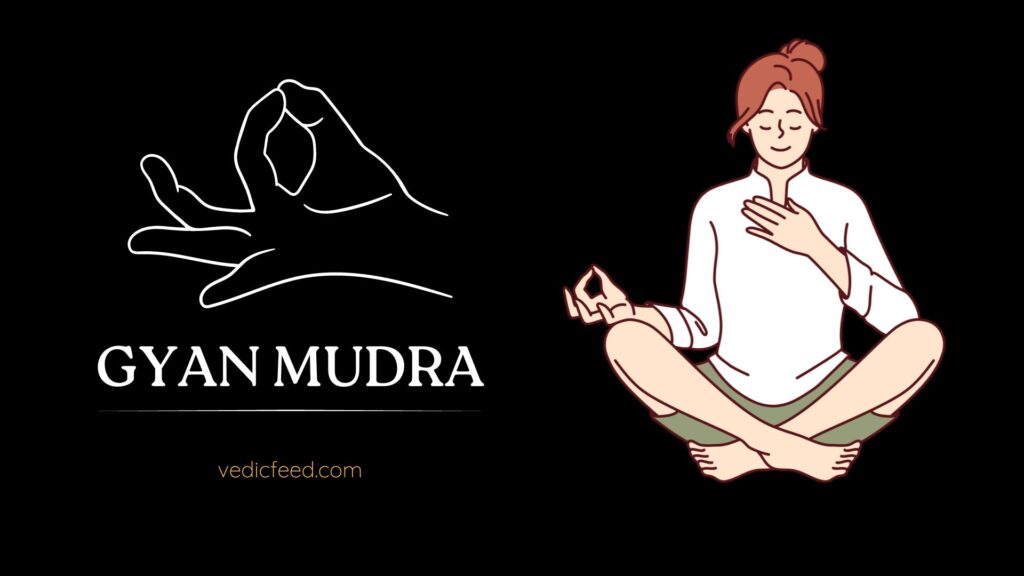As we traverse the path of yoga, meditation, and spiritual growth, we come across various practices and techniques that aid our journey toward higher consciousness.
One such technique is the use of mudras, which are symbolic gestures or positions often used during meditation or pranayama breathing exercises. Mudras have been a part of spiritual practices for centuries, and their benefits are well documented in Vedic texts.

Contents show
What is Gyan Mudra?
Gyan Mudra (Jnana Mudra, Chin Mudra, Dhyan Mudra, and Vayu-Vardhak Mudra), also known as the Mudra of Knowledge, is a hand gesture that is often used in yoga and meditation practices. Its main purpose is to focus the mind during meditation.
It is a simple yet powerful mudra that can be practiced by anyone, regardless of age or gender. This yoga hand gesture is formed by touching the tip of the index finger to the tip of the thumb while keeping the other three fingers straight.
Index finger and Thumb finger
Index finger – Associated with planet Jupiter
Index finger bending towards thumb – Individual consciousness
Index finger – Individual soul
Thumb finger – supreme soul
The Origin of Gyan Mudra
The Gyana Mudra has been used in Indian spiritual practices for thousands of years. It is believed that the gesture originated in ancient Hindu culture, where it was used by sages and seers during meditation and pranayama breathing exercises to increase their knowledge and wisdom.
The word “gyan” itself means “knowledge” or “wisdom” in Sanskrit, making the Gyan Mudra the Mudra of Knowledge. The index finger is itself connected to Jupiter, the planet of knowledge, so this mudra is the mudra of Knowledge.
The Science Behind Gyan Mudra
The human body is a complex web of energy channels and centers, and the practice of mudras is based on the principles of energy flow. The fingers of our hands represent the five elements – air, water, fire, earth, and ether – and each finger is associated with a particular element.
In the Gyan Mudra, the index finger represents the air element, while the thumb represents the fire element. According to Ayurveda, the air element is associated with the Vata dosha, which governs the nervous system and the mind. The fire element is associated with the Pitta dosha, which governs metabolism and digestion.
When we touch the tip of the index finger to the tip of the thumb in the Gyan Mudra, we create a circuit that allows the energy to flow freely through the body. This, in turn, stimulates the brain and the pituitary gland, which is responsible for releasing hormones that regulate growth and development.
The Gyan Mudra also activates the heart chakra, which is associated with love, compassion, and emotional balance. Regular practice of the Gyan Mudra can help in balancing the Vata and Pitta doshas, improving mental clarity, memory power, and overall physical health.
Gyan Mudra and deities
Gyan mudra is a hand gesture that represents knowledge and wisdom in Hinduism and Buddhism. It is often depicted in religious iconography, including statues and images of deities. Many deities are shown performing the gyan mudra, including:
- Lord Buddha: The ninth avatar of Lord Vishnu and the founder of Buddhism is often depicted with his right hand in the Purna Gyan Mudra while his left hand is in the dhyana mudra, which represents meditation. Purna Gyan Mudra reflects the attainment of wisdom of enlightenment and Vitarka Mudra is a transmission of knowledge. Lord Buddha is iconic-graphed in both of these mudras.
- Lord Shiva: The Hindu god of destruction is sometimes depicted with the gyan mudra, as it is associated with knowledge and wisdom.
- Lord Ganesha: The elephant-headed deity is also depicted with the gyan mudra, which represents his status as the god of intellect and wisdom.
- Goddess Saraswati: The Hindu goddess of knowledge, music, and the arts is often depicted with the gyan mudra, as it represents wisdom and learning.
- Lord Mahavira: The 24th and last Jain Tirthankara is often depicted with the gyan mudra, which is associated with enlightenment and liberation.
Gyan Mudra in Sanskrit texts
नासाग्र-न्यस्त-नेत्रत्वम् अवधूत-विचेष्टितम् ।
युग-मात्रेक्षित-गतिर् ज्ञान-मुद्रा-प्रदर्शनम् ॥Bhakti Rasamrta Sindhu – verse 3.1.24
The shloka describes Gyan Mudra as having the qualities of “nasagra-nyasta-netratvam” which means the gaze of the eyes is fixed on the tip of the nose, “avadhuta-vicestitam” which means the body is still and motionless, “yuga-matreksita-gatir” which means the movement of the body is as slow as the passing of an age, and “jnanamudra-pradarshanam” which means the gesture shows the display of wisdom. Overall, the shloka suggests that practicing Gyan Mudra helps to calm the mind and body, and is associated with the display of wisdom.
सुधासिन्धोः शुद्धा निवसति कमले साकिनी पीतवस्त्रा
शरं चापं पाशं सृणिमपि दधति हस्तपद्मईश्चतुर्भिः ।
सुधांशोः संपूर्णं शशपरिरहितं मण्डलं कर्णिकायां
महामोक्षद्वारं श्रियमभिमतशीलष्य शुद्धेन्द्रियस्य ॥Shat-cakra-nirupana (the six bodily centres) verse 30
Let the excellent Sadhaka meditate in the throat lotus on the Devi Sakini. She is light itself (Jyoti-svarupa): each of Her five beautiful faces is shining with three eyes. In Her lotus hands She carries the noose, the goad, the sign of the book, and makes the Jnana Mudra (Gyan Mudra). She maddens (or distracts) all the mass of Pasus, and She has her abode in the bone. She is fond of milk food, and elated with the nectar which She has drunk.
How to Practice Gyan Mudra?
Practicing the Gyan Mudra is easy and can be done at any time of the day. Here’s how to do it:
- Sit in a comfortable position, preferably in a meditative pose like Padmasana or Sukhasana.
- Relax your whole body, take a deep breath, and exhale slowly.
- Touch the tip of your index finger to the tip of your thumb while keeping the other three fingers straight. (Note: For the prana method, add pinky fingers to touch the tip of your thumb, keeping the other two fingers straight.)
- Rest your hands on your knees, with palms facing upwards.
- Close your eyes and focus on your breath while holding the mudra.
To experience the maximum benefits of the Gyan Mudra, it is recommended to practice it for at least 20 minutes a day. You can also practice it during pranayama breathing exercises or while reciting mantras.
Benefits of Gyan Mudra

Physical benefits
Enhances Memory and Concentration: Gyan Mudra helps to improve our memory and concentration by stimulating the pituitary gland, which is responsible for the production of hormones that regulate growth, metabolism, and body temperature.
Boosts Brain Power: This Yogic hand gesture enhances the functioning of the brain by balancing the left and right hemispheres. This helps to increase our cognitive abilities and improve our decision-making skills.
Improves Mental Health: Gyan Mudra is an excellent tool to combat negative emotions like anxiety, stress, and depression. It helps to reduce the levels of stress hormones like cortisol and increases the production of mood-enhancing hormones like serotonin and dopamine.
Increases Self-Awareness: Practicing Gyan Mudra can help us connect with our inner self and access our true knowledge. It helps to increase self-awareness and understanding of our thoughts and emotions.
Enhances Yoga Practices: Gyan Mudra is an excellent complement to yoga practices. It helps to deepen the meditative state and improves the effectiveness of yoga postures.
Spiritual benefits
Accessing True Knowledge
Gyan Mudra is also known as the Mudra of Wisdom because it can help you access true knowledge or higher wisdom. By connecting the index finger with the thumb, Gyan mudra activates the pituitary gland, which is responsible for regulating the endocrine system and secreting hormones that affect our physical and emotional well-being. When the pituitary gland is activated, it can enhance our intuition and perception, allowing us to access higher levels of consciousness.
Opening the Heart Chakra
Gyan Mudra is also associated with the heart chakra or Anahata chakra, which is located in the center of the chest and is associated with love, compassion, and connection. By activating the heart chakra, Gyan mudra can help us cultivate a deeper sense of empathy and compassion towards ourselves and others, leading to greater spiritual growth and well-being.
Balancing the Air Element
Gyan Mudra is also associated with the air element (apana vayu), which is one of the five elements in Ayurveda and is associated with the qualities of movement, lightness, and expansiveness. By balancing the air element, Gyan mudra can help us cultivate a sense of lightness and ease in our physical and mental bodies, allowing us to move through life with greater grace and ease.
Activating Root Chakra and Vital Life Force
The root chakra is associated with a sense of security, stability, and grounding. Gyan Mudra helps to stimulate the root chakra and enhances our connection with the earth and the universe. Gyan Mudra helps to activate the vital life force or Prana in our body. It enhances the energy flow of prana and awakens our dormant energy centers, leading to overall health and well-being.
Gyan Mudra Contraindications
Gyan mudra is generally safe for most people to practice. However, in some cases, it may not be suitable or may need to be modified. Here are some contraindications to consider:
Carpal Tunnel Syndrome: If you have carpal tunnel syndrome or any other hand or wrist injury, Gyan mudra may aggravate the symptoms.
Low Blood Pressure: Gyan mudra may lower your blood pressure, so if you already have low blood pressure, it is best to avoid practicing this mudra or to practice it for a shorter duration.
Hyperventilation: Gyan mudra may increase the oxygen flow in the body, so if you are prone to hyperventilation, you should avoid practicing this mudra. This may cause chest pain, respiratory issues, and chronic coughing.
Pregnancy: In some cases, Gyan mudra may stimulate the uterus and cause contractions, so it is best to avoid practicing this mudra during pregnancy.
Mental Health Conditions: Gyan mudra is associated with calming and focusing the mind. However, for those with certain mental health conditions such as anxiety, depression, or obsessive-compulsive disorder, it may not be suitable or may need to be modified.
As with any new exercise or practice, it is always advisable to consult with a qualified yoga instructor or healthcare professional before starting.
Gyan mudra is a simple and effective Yoga Mudra that can be practiced by anyone, anywhere, and at any time. It has been used for thousands of years in yoga and meditation practices to improve focus, concentration, and mental clarity. To express in one word: From ignorance to wisdom!
Incorporating gyan mudra into your daily routine with precautions can be a simple yet powerful way to enhance your physical and mental health. With regular practice and mindfulness, you may begin to experience the many benefits of this ancient yogic practice.




